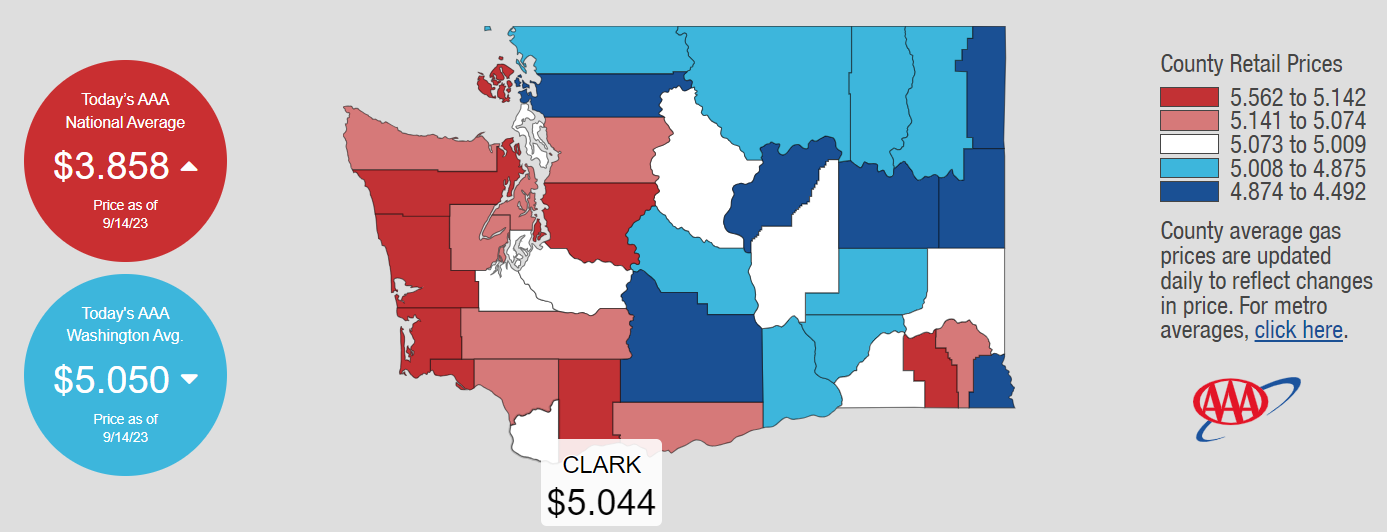Sept. 14, 2023
Hello Friends and Neighbors,
Earlier this week the gas-prices webpage from AAA had this headline: “Gas Prices Slump Slightly as Summer’s End Approaches.” Maybe in other states, but not ours. When I last checked in with you, it was mid-July and gas in Skamania County was $5.22 a gallon for regular unleaded. Today it’s $5.37! Not only is this a jump in prices, rather than a slump, but there’s nothing slight about it. The pain is less in Clark County, as the map below shows, but gas is still several cents over $5/gallon, almost identical to the average price statewide.
While gas prices continue making life in our state harder to afford, it’s good that parents in Clark County are no longer being forced to take time off work because of teacher strikes. Still, I have concerns about what’s going on with our public schools… and then there’s the fentanyl epidemic, which also has a school angle. Please keep reading for more on both.
 Despite claims, high gas prices are clearly due to climate policy
Despite claims, high gas prices are clearly due to climate policy
Governor Inslee would have us believe it is just coincidence that Washington gas prices began climbing once his “cap-and-trade” climate policy – which functions as a carbon tax – took full effect at the start of 2023. Since late spring, the cost of a gallon of regular unleaded in Washington has either been highest in the United States, or second only to California. Meanwhile, gas prices have declined in most of the nation.
The governor has been rightfully criticized for claiming his approach would only add “pennies” per gallon to gas prices. He told that whopper more than a year ago, after skeptics began forecasting a price jump of up to 45 cents once 2023 arrived. Little did anyone know the price would instead jump nearly three times that much.
The cap-and-trade law, officially called the Climate Commitment Act (CCA), was passed when public debate over it and other polarizing legislation (like the virtual decriminalization of hard drugs) was restricted by the pandemic lockdown. Since auctions of “carbon allowances” began this year, the state has already raked in more than $1 billion, with another auction coming in December.
That’s a much bigger haul than projected by legislative budget writers, making the CCA look more like a government money-grab than a real carbon-reduction strategy. Knowing the majority Democrats have no interest in lowering gas prices (which we could do by suspending the gas tax), Senate Republican Leader John Braun plans to propose a different use for the financial windfall from the CCA: provide a combination of property-tax exemption and renter’s credit, similar to legislation I’ve proposed through SB 5387. Click here for his perspective.
Inslee, meanwhile, keeps trying to “gaslight” the people of Washington, desperate to distract us from the obvious correlation between the kickoff of carbon pricing and the climb in gas prices. The governor “doesn’t deny” the CCA has an effect on price, his spokesman wants us to know, but Inslee maintains the culprits are oil companies and their “profiteering,” adding that the Legislature needs to investigate.
I’ll just point out that Washington gas on average costs around 30 cents more than the average Oregon gas price, and around 90 cents more than the average in Idaho. If the oil companies truly wanted to maximize their profits, why pick on just one of these three states? Or, why is the national average $3.84 per gallon, meaning some states are far less than that to offset the $5+/gallon in Washington and California? Inslee’s accusation doesn’t pass the chuckle test.
Proof that the CCA does affect energy prices recently came from an unlikely place: the state Utilities and Transportation Commission, in a decision that affects Puget Sound Energy, supplier of electricity and/or natural gas in 10 western Washington counties.
A month ago, the UTC basically agreed PSE could raise its natural-gas rates by about 3 percent to cover part of the added cost of complying with the CCA. However, in the same breath, the UTC went along with the advice of its legal counsel – which comes from the state attorney general’s office – that PSE “should not include the proposed ‘carbon reduction charge’ as a line item on customer bills,” because “including all program charges on customer bills would quickly result in lengthy and confusing bills.”
Shame on Attorney General Bob Ferguson and his office for suggesting PSE customers would be unable to understand their energy bills simply because one line is added to detail the effect of the Climate Commitment Act. The better question is, why in the world would Ferguson want to prevent a natural-gas supplier from being transparent with its customers? I think we can figure out who benefits by hiding how the cap-and-trade policy is costing consumers more.
While strikes are over, K-12 concerns remain
One of my grandchildren was all set to start kindergarten this year in the Evergreen School District – and then the teachers decided to strike. He was very disappointed. Also, one of the first messages to my Senate email after Camas teachers walked out was from an unhappy Camas parent, saying though they support education, the striking teachers were essentially holding the community hostage.
I was reminded of this disconnect: As it “is the paramount duty of the state to make ample provision for the education of all children residing within its borders,” under Washington’s constitution (emphasis mine), why do the children suffer when the adults can’t settle their differences on time?
During the Evergreen strike I was interviewed by the Washington State Standard, as I represent Clark County and am Senate Republican budget leader (I doubt the reporter knew I’m also an Evergreen grad). Read the interview here for my take on the legality of teacher strikes (they’re not, as also noted by The Columbian), and the fate of the special-education funding mentioned as a sticking point in the contract negotiations.
What didn’t make it into the report are my concerns about how a huge pot of federal Elementary and Secondary School Emergency Relief (ESSER) funding is being handled, by Superintendent of Public Instruction Chris Reykdal’s office and local districts. I’ve gone back and forth with the SPI office about this, and the data I received this week indicate less than 10% of the $1.85 BILLION our state has received in ESSER funding, all told, has gone toward afterschool programs and summer school and learning loss. How lopsided is that, and what happened to the remaining $1.67 billion? Has some (or more than some) been bargained away, like happened several years ago with money the Legislature had designated for reducing class sizes?
When I recently tried to have a productive conversation about this with SPI Reykdal, he reacted adversely to my use of the term “learning loss” and told me Washington students haven’t gone “backwards”… they just haven’t progressed “the way we typically would expect.”
Huh? If the expected level of learning hasn’t been reached, what is that if not a loss?
The end of the local teacher strikes is good because our students can’t afford to lose any more instruction time. The learning-loss concern is very real, no matter what the SPI wants to admit. The scores from this spring’s K-12 assessment back that up, with the “at grade level” metric for students closest to graduating – this past year’s 10th-graders – declined from the previous year’s testing in both English and math.
English
- 7% students met standard for their grade level, the same as last year’s % (50.7%)
- In spring 2021, the figure was 47.7%, but pre-pandemic (spring 2019) the figure was 59.6%
Math
- 1% students met standard for their grade level, slightly higher than last year (37.7%)
- In spring 2021, the figure was 30.4%, but pre-pandemic (spring 2019) the figure was 48.9%.
That’s a big gap to close, and business as usual in our classrooms is not likely to turn things around. There was a bipartisan effort in the state Senate this year to focus the use of unspent ESSER money on intensive tutoring and other learning-recovery methods, but the majority in the House opted to let SPI Reykdal – a former member of that majority – keep control of those dollars. Not a good idea, in my book.

It was my privilege Monday to attend the Patriots Day Salute and 9/11 Remembrance organized by the Community Military Appreciation Committee and the City of Vancouver. If you haven’t had the opportunity yet, I hope you do someday. Thank you, CMAC (and the city) for making this possible.
‘Synthetic opioids’ like fentanyl need to be higher public-safety priority
The last day of August was International Overdose Awareness Day – initiated more than 20 years ago in Australia – and ICYMI, here’s why I publicized that on my Senate page on Facebook.
No state is seeing fatal drug overdoses increase more than Washington. The federal Centers for Disease Control keeps track of this, even though the figures are a few months old by the time they’re compiled. For the March 2022-23 period, the latest 12-month span for which statistics were available, there was a 28.4% increase in fatal overdoses in our state.
Sadly, this isn’t breaking news – it’s the third consecutive monthly report from the CDC that has our state ranked worst in terms of overdose increase by percentage. The same report also has our state now ranking worst for number of deaths by drugs, with 688 more than in the prior 12-month period.
With countless Washington families being harmed by fatal overdoses, and so many of our communities battling the homelessness and crime related to hard drug use, I still shake my head at how it was such a struggle to get a tougher drug-possession law in place this year. Many of us had predicted the majority’s drug-decriminalization social experiment would be a disaster, and unfortunately, saying “we told you so” can’t undo all the damage done these past 2 years. As they say… the proof is in the pudding.
Attorney General Bob Ferguson recently issued a news release headlined “AG Ferguson urges addition of Everett, Spokane, Yakima to federal initiative fighting fentanyl crimes.” There’s nothing wrong with that, I guess, but where was Ferguson when his fellow Democrats in the House were blocking my bill targeting synthetic opioids (SB 5010), after it passed unanimously in the Senate? Maybe he was too busy with his seven-year crusade against modern sporting rifles… or does he really expect little kids to defend themselves against being exposed to fentanyl by adults?
The Legislature spent an awful lot of time this past session dealing with a pair of public-safety issues tied to poor decisions made in 2021: the drug-decriminalization mentioned above, which stemmed from the state Supreme Court’s Blake decision that same year, and the police-pursuit restrictions.
I realize the Legislature has no say about security at the U.S. borders, which has much to do with the fentanyl crisis, but the list of priorities for our 2024 session need to include a serious discussion about what can be done at the state level. There’s something wrong when, as a recent TV news report points out, many Washington school districts must make the overdose-reversing drug Narcan available to students… yet fentanyl education isn’t required in schools.
***
I hope you will reach out whenever you have a comment or question about your state government.
Yours in service,

Follow me on Facebook and Instagram!
To read this e-newsletter in other languages, click here to visit my Senate news page and find the “Select Language” menu in the upper left corner!










